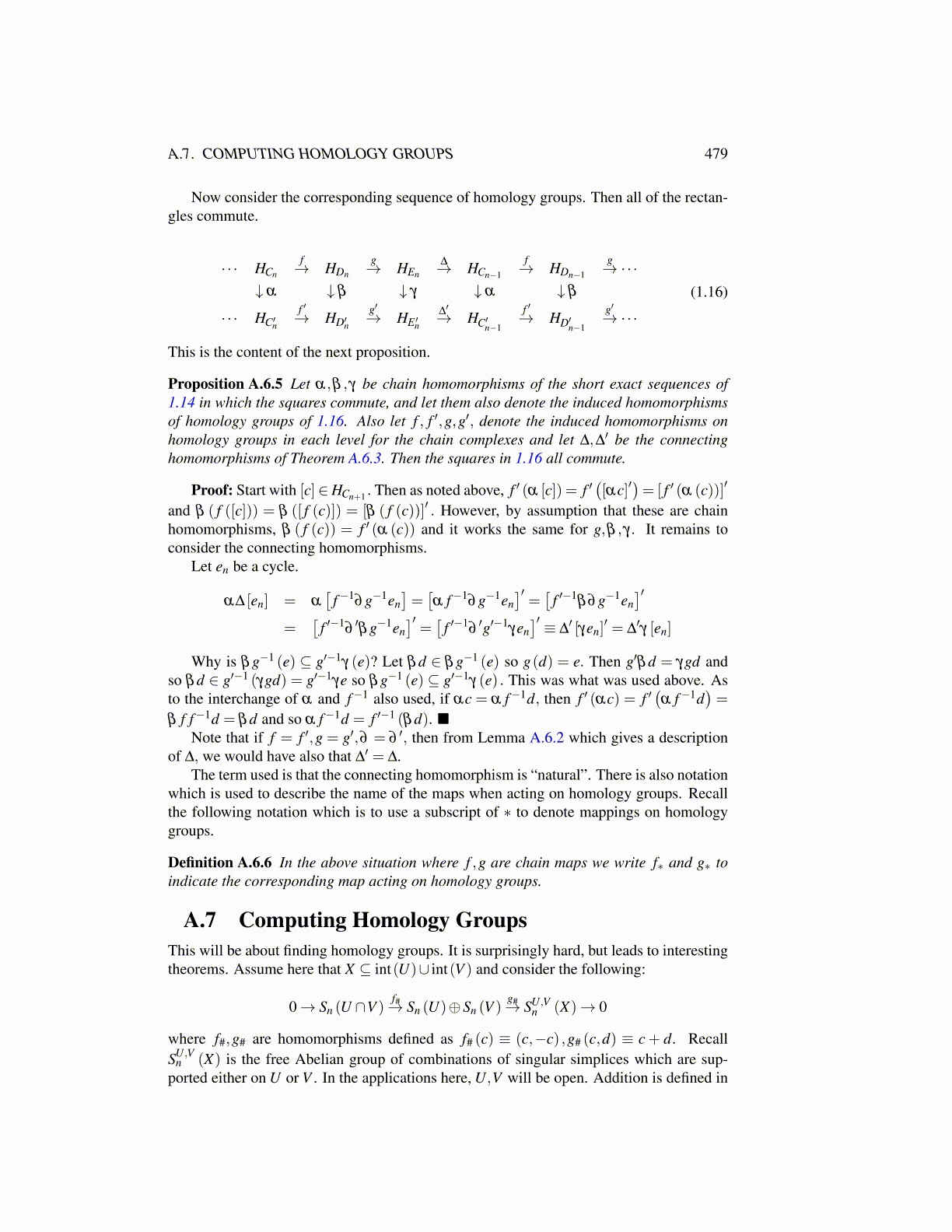
A.7. COMPUTING HOMOLOGY GROUPS 479
Now consider the corresponding sequence of homology groups. Then all of the rectan-gles commute.
· · · HCn
f→ HDng→ HEn
∆→ HCn−1
f→ HDn−1
g→ ···↓ α ↓ β ↓ γ ↓ α ↓ β
· · · HC′nf ′→ HD′n
g′→ HE ′n∆′→ HC′n−1
f ′→ HD′n−1
g′→ ···(1.16)
This is the content of the next proposition.
Proposition A.6.5 Let α,β ,γ be chain homomorphisms of the short exact sequences of1.14 in which the squares commute, and let them also denote the induced homomorphismsof homology groups of 1.16. Also let f , f ′,g,g′, denote the induced homomorphisms onhomology groups in each level for the chain complexes and let ∆,∆′ be the connectinghomomorphisms of Theorem A.6.3. Then the squares in 1.16 all commute.
Proof: Start with [c]∈HCn+1 . Then as noted above, f ′ (α [c]) = f ′([αc]′
)= [ f ′ (α (c))]′
and β ( f ([c])) = β ([ f (c)]) = [β ( f (c))]′ . However, by assumption that these are chainhomomorphisms, β ( f (c)) = f ′ (α (c)) and it works the same for g,β ,γ . It remains toconsider the connecting homomorphisms.
Let en be a cycle.
α∆ [en] = α[
f−1∂g−1en
]=[α f−1
∂g−1en]′=[
f ′−1β∂g−1en
]′=
[f ′−1
∂′βg−1en
]′=[
f ′−1∂′g′−1
γen]′ ≡ ∆
′ [γen]′ = ∆
′γ [en]
Why is βg−1 (e) ⊆ g′−1γ (e)? Let βd ∈ βg−1 (e) so g(d) = e. Then g′βd = γgd andso βd ∈ g′−1 (γgd) = g′−1γe so βg−1 (e) ⊆ g′−1γ (e) . This was what was used above. Asto the interchange of α and f−1 also used, if αc = α f−1d, then f ′ (αc) = f ′
(α f−1d
)=
β f f−1d = βd and so α f−1d = f ′−1 (βd). ■Note that if f = f ′,g = g′,∂ = ∂ ′, then from Lemma A.6.2 which gives a description
of ∆, we would have also that ∆′ = ∆.The term used is that the connecting homomorphism is “natural”. There is also notation
which is used to describe the name of the maps when acting on homology groups. Recallthe following notation which is to use a subscript of ∗ to denote mappings on homologygroups.
Definition A.6.6 In the above situation where f ,g are chain maps we write f∗ and g∗ toindicate the corresponding map acting on homology groups.
A.7 Computing Homology GroupsThis will be about finding homology groups. It is surprisingly hard, but leads to interestingtheorems. Assume here that X ⊆ int(U)∪ int(V ) and consider the following:
0→ Sn (U ∩V )f#→ Sn (U)⊕Sn (V )
g#→ SU,Vn (X)→ 0
where f#,g# are homomorphisms defined as f# (c) ≡ (c,−c) ,g# (c,d) ≡ c + d. RecallSU,V
n (X) is the free Abelian group of combinations of singular simplices which are sup-ported either on U or V . In the applications here, U,V will be open. Addition is defined in